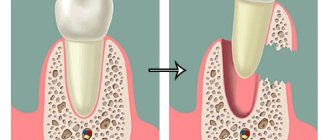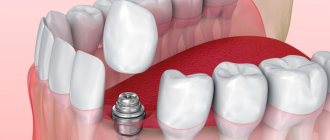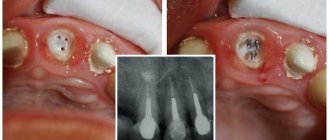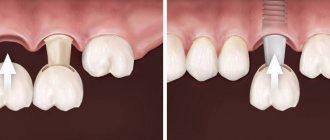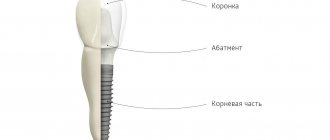Implantation of chewing teeth – upper and lower. Which implant and crown is best for chewing teeth? Which is better, a bridge or an implant? Specialists at the Implantmaster clinic will select the best option for implanting chewing teeth using the latest diagnostic equipment. We use premium implantation systems at affordable prices.
Despite the increased strength of teeth in the chewing area, they are more susceptible than others to carious lesions, inflammatory processes and losses. Moreover, when units are lost in this area, serious aesthetic problems and disturbances in the functioning of the gastrointestinal tract can occur. All of the above negative manifestations are due to the direct participation of teeth in the process of chewing food and, as a result, excessive load. To eliminate such a pathology, it is necessary to urgently contact dentistry to perform implantation.
At the Implantmaster clinic, the process of recreating teeth in the chewing department is carried out by experienced specialists, based on modern protocols, using special surgical templates and innovative digital equipment. This significantly increases the accuracy of the procedures, minimizes pain, shortens the period of implementation and ensures a successful and long-term result.
Next, we will talk in more detail about implantation of chewing teeth , consider the specifics of performing the procedure in the maxillary and mandibular regions, and also introduce you to the pricing policy and existing reviews. We hope that the information received will help you draw the right conclusions about the need to install implants on your chewing teeth, and you will learn to understand its intricacies.
Get a consultation
We will answer all your questions before visiting the clinic!
+7
Online registration
Content
1 What are the consequences of losing teeth in the chewing area?
2 Implantation of chewing teeth on the upper jaw
3 Implants of the lower chewing teeth
4 Which implant is better to place on chewing teeth?
5 Bone grafting for implantation of lateral teeth
6 Which crowns are best fixed to a chewing tooth implant?
7 Methods of implantation of chewing teeth
8 Which is better – a bridge or an implant for chewing teeth?
9 Prices for implantation of chewing teeth
10 Reviews about implantation of chewing teeth
11 Alternative options
Possible options for installing implants
The choice of method depends on the number of missing teeth and the condition of the patient's jaw bone.
- In the absence of 1-2 teeth.
Implantation of chewing teeth is carried out according to the classical protocol. The doctor first installs the implants, then waits 2-4 months for them to fuse with the bone tissue. As a rule, systems take root faster on the lower jaw than on the upper jaw, since the bone here is denser. At the end of the engraftment period, a temporary prosthesis is installed on the implants, and after another month - a permanent one. The peculiarity of classical implantation is that it requires the patient to have a sufficient amount of bone tissue. But with the absence of teeth for a long time, most people experience bone atrophy (thinning). Therefore, before implanting molars, it is necessary to carry out additional intervention - bone grafting. - In the absence of 3 or more teeth.
Basal implantation is optimal. The advantage of this technique is that it does not require preliminary bone augmentation and allows the installation of implants along with the prosthesis in just 2-4 days. Unlike classical ones, basal implants are fixed not in the superficial, but in the deepest layers of the jaw, which do not decrease over time. The lower layers are harder and stronger, so the systems are securely held in them and do not loosen under load. After 2-4 days, after the soft tissues have healed, the implants are covered with a prosthesis. The design is non-removable and fully functional. Almost immediately, patients can chew moderately solid food, and after a week they return to their usual diet. The only disadvantage of basal implantation of molars: it is not applicable to patients with 1-3 missing teeth in a row. The fact is that basal implants are fixed at an angle and in the limited volume of bone there may simply not be enough space for them.
What are the consequences of losing teeth in the chewing area?
Despite their reliability, molars and premolars are among the most susceptible teeth to pathogenic bacteria. This is due to their active participation in the process of chewing food products. Severe pathologies in the chewing area can provoke tooth loss. This, in turn, can cause such serious problems as deterioration of the anatomical characteristics of the face, disturbances in the functioning of the maxillofacial system, disruptions in the functioning of the gastrointestinal tract and other undesirable changes.
Currently, the most effective method of eliminating the defect is the implantation of chewing teeth. However, the procedure for reproducing molars and premolars differs in its specific features, which we will discuss later.
Implantation of chewing teeth in the upper jaw
It should be noted that the maxillary and mandibular sections have their own unique specific structure. In this case, an important point when losing a tooth in the upper jaw is rapid atrophy. That is, if several years have passed since the loss of such a unit, then a necessary condition for successful fixation of implants will be raising the lower part of the maxillary cavity (performing a sinus lift).
If the tooth is subject to extraction or its loss occurred not so long ago, you can resort to instant methods. During them, the fixation of the prosthetic device is carried out immediately after the insertion of the chewing tooth implant. Due to instant loading, an accelerated period of osseointegration is achieved, equal to 12-16 weeks (3-5 weeks with Straumann implants).
The implant of the upper chewing tooth can also be fixed using the traditional method, which involves step-by-step treatment. However, the load in this case can be carried out only after the end of the engraftment period.
When deciding to install an upper posterior dental implant, you should be aware of the risks associated with this procedure. They are caused, first of all, by the proximity of the maxillary cavities. With an incompetent approach, there is an increased likelihood of injury and the appearance of inflammatory processes.
In our dentistry, consultations are conducted by competent specialists who know all the intricacies of fixation of dental systems in the maxillary region. This guarantees the safety of the manipulations and ensures a prolonged result without complications.
Why implantation and not a bridge or removable denture?
- A dental bridge
is only suitable for included defects with a total length of no more than 4 teeth. The main disadvantage is that it requires grinding down two adjacent teeth for support. Sometimes these are completely healthy teeth that have to be covered with crowns. Service life 7-9 years. Does not prevent bone tissue atrophy. - A removable denture
is secured to crowns or natural teeth using special hooks. Most often, structures are made with support on an artificial palate, which makes them very uncomfortable to wear, can change diction, and provoke increased salivation and nausea. Fixation hooks put pressure on the tooth tissue, causing discomfort. Service life 3-5 years. Does not prevent bone tissue atrophy. - A bridge on implants
does not destroy other teeth, distributes the load evenly and is an excellent prevention of bone atrophy. It will cost more, but it will feel and look like your own teeth. It is not a source of discomfort, light and neat. Allows 100% restoration of the chewing function of the lateral parts of the jaw.
Our team of doctors
Maxillofacial surgeon, Implantologist
Bocharov Maxim Viktorovich
Experience: 11 years
Dental surgeon, Implantologist
Chernov Dmitry Anatolievich
Experience: 29 years
Orthopedist, Neuromuscular dentist
Stepanov Andrey Vasilievich
Experience: 22 years
Endodontist, Therapist
Skalet Yana Alexandrovna
Experience: 22 years
Orthopedic dentist
Tsoi Sergey Konstantinovich
Experience: 19 years
Dentist-orthodontist
Enikeeva Anna Stanislavovna
Experience: 3 years
Stages of implantation with immediate loading
Installation of implants and temporary prosthetics is carried out in one visit. Installation of permanent structures - after the implants have fused with the bone.
- Implant installation is carried out under local anesthesia or sedation. It is possible to install it in the socket of an extracted tooth. For full implantation, a surgical template is used.
- Immediate prosthetics A temporary plastic crown is immediately installed for a single restoration or a prosthesis for complete restoration of teeth.
- Permanent prosthetics When the implant fuses with the bone, the temporary crown is replaced with a zirconium crown, and the adaptive prosthesis with the one specified in the protocol.
A permanent crown can be placed after 3-4 months. In cases where the bite is restored and the masticatory muscles begin to work as usual, it can be installed earlier (assessed during control CT examinations). Complete permanent dentures are installed within a period of 6 months to a year.
Implantation in our Center is performed only by maxillofacial surgeons and implantologists with daily work experience of at least 5 years. These are first-class specialists with developed clinical thinking and sufficient practical skills. They are fluent in Nobel Biocare® surgical protocols and undergo annual training based on the company’s educational programs.
Implants of the lower chewing teeth
If you require implantation in the lower jaw in the area of chewing teeth, then there is a high probability that this procedure will be carried out using a two-stage method. During the first step, the specialist will perform surgery, after which he will suture the gum tissue. At the second stage, the prosthetic device is fixed, a prerequisite for which is complete engraftment of the dental implant.
It should be noted that if implants of the lower chewing teeth are installed using classical technology, this requires the presence of bone tissue with sufficient density and height. If a CT scan reveals a lack of bone tissue, osteoplasty is an integral part of the implantation. This manipulation involves the transplantation of donor or artificial bone blocks.
The treatment period in this case can be significantly delayed, which is explained by the need to restore bone tissue and achieve the required parameters. But in some situations, the osteoplastic procedure can be performed simultaneously with the introduction of dental structures.
In our dentistry, you can get advice from qualified specialists, which will allow you to determine the need for osteoplastic procedures. In addition, we use the latest oral scanners, which guarantees highly accurate diagnostics and proper planning of further treatment measures.
Features of restoration of teeth in the upper jaw
- The maxillary bone is less dense than the lower bone and therefore undergoes atrophy more quickly. If teeth have been missing for a long time, the patient may need bone augmentation (sinus lift surgery) before implantation.
- When using the classical technique, the engraftment period is 3-4 months.
- For single restorations, a one-stage protocol with immediate crown fixation is allowed due to lower chewing loads.
- When implanting in the upper jaw, the doctor requires “jeweller” precision. The accessory nasal sinuses and large nerves pass near the implantation zone.
- It is possible to use elongated (zygomatic) implants.
Which implant is best for chewing teeth?
It is a mistake to believe that doctors use the same type of implants to recreate all teeth. For each individual situation, a different method of prosthetics and implantation system are used, which guarantees the success of the procedure in terms of aesthetic and functional parameters.
First of all, in order to understand which implant is best to place on chewing teeth, you should take into account the anatomical parameters of the jaw structure. Taking into account these features, the doctor selects the size of the implant for the chewing tooth.
If we talk about methods of recreating teeth in the lateral region, most often the traditional method is used here, which involves a step-by-step procedure. In this case, the dental system is initially fixed, and only 12-24 weeks after this, the orthopedic structure is installed. The unique SLActive surface from ]Straumann[/anchor] reduces this period to 3-5 weeks. This is due to the need for high-quality osseointegration of the system with bone tissue. During the healing period, the patient usually wears a temporary prosthetic device.
Almost all modern manufacturers have dental implants in their arsenal, designed to restore teeth in the chewing area. Both premium quality systems and budget models are suitable for this purpose. However, products from the Swiss brand Straumann allow you to get the best aesthetic effect and achieve the necessary functionality. In any case, only a competent specialist in a trusted dental clinic can Which implant is better to place on chewing teeth?”
We offer significant discounts on the installation of top-end implantation systems, which allows you to get an impeccable result with a long guarantee. You can also get competent advice from our doctors regarding which implants are best placed on chewing teeth. Our specialists have impressive experience in restoring the aesthetics and functionality of the side section.
Rating of dental implant manufacturers »
What materials are used for implantation and prosthetics of chewing teeth?
Working with the lateral parts of the jaw is less tied to the aesthetic factor. But there are more requirements for the functionality and reliability of titanium rods and prostheses. When choosing implants, the doctor focuses on larger samples with pronounced threads, because each unit will have to bear a colossal load.
The type and design features of the implant are selected individually, including depending on the volume of bone tissue. Titanium abutments are recommended for prosthetics of this group of teeth. As for crowns, they have proven themselves well:
- Zirconium dioxide
. From this mineral it is possible to obtain lightweight bridges suitable for replacing defects of any length. This is a durable and practical material processed by a PC-controlled machine. Human participation is minimized, so the prosthesis is highly accurate - according to a laser scan from a jaw cast. Its service life: 10-20 years. Today, the cost of zirconium dioxide crowns is comparable to metal-ceramic crowns. - Metal ceramics
. This material is less practical and inexpensive. For chewing teeth, if it is not possible to install zirconium crowns, this is used. It is used for prosthetics of included and terminal defects of the jaw. Disadvantages include possible chipping of ceramics, as well as allergies to metal.
But ceramics for prosthetics of molars and premolars are used only as single crowns. It is not strong enough for bridges.
Bone grafting for implantation of lateral teeth
It is not possible to fix molar implants in the chewing area if there is a deficiency of bone tissue; an osteoplastic procedure is mandatory. We discussed this point in the previous paragraphs of the article. The process of increasing the size of bone tissue is performed by raising the lower part of the maxillary cavities (in the maxillary region), or by transplanting bone contents (in the maxillary region).
It will not hurt to know that only implantation can stop the process of bone tissue resorption. That is, if the question arises: “ Crown or implant for chewing teeth?”, we can definitely speak in favor of the latter option. As for the removable orthopedic structure, the process of bone loss continues to progress even after its installation.
Read more about bone grafting for dental implants »
When is bone grafting needed?
This term refers to osteoplastic surgery. Their goal is to replace bone tissue lost as a result of atrophy with a biocompatible material. After tooth extraction, the jaw area ceases to experience chewing load. The vessels die and stop feeding the bone. This leads to its resorption (resorption), which makes the jaw tissue loose. Already 3-6 months after removal, atrophy begins if the patient does not have an implant installed. Only implantation can stop atrophy. Under removable dentures, bone resorption continues because there is no proper load on the bone.
The decision to perform osteoplasty is made by the doctor based on the clinical picture, as well as the chosen technique for implanting the titanium root. They resort to extension:
- with thinning and changes in bone density;
- in case of congenital bone deficiency or other anatomical features;
- for injuries of the dentofacial apparatus in the area of installation of a titanium support.
With classical implantation, sufficient bone volume is a prerequisite. Therefore, if there is a deficiency, preliminary tissue extension is carried out in a separate stage. It takes up to six months for the planted material to take root.
With one-stage implantation, due to the special shape of the implants, implantation can be carried out in conditions of moderate bone tissue atrophy. If it is not enough, osteoplasty is combined with the introduction of a titanium support. If there is practically no bone tissue, the operation is performed at the preparatory stage.
Osteoplasty in the area of chewing teeth is different:
In the lower jaw, surgery is necessary when the height or width of the alveolar process decreases, when the distance to the mandibular canal decreases. The methods used are directed bone regeneration, bone block grafting, and alveolar ridge splitting.
Bone grafting of the upper jaw is otherwise called sinus lift. The sinuses are called the maxillary sinuses. The purpose of the surgical intervention is to lift their lower part. The space is filled with osteoplastic material. The operation is performed before or in conjunction with implantation. Sinus lifting is performed using open and closed methods:
- for simultaneous implantation, a closed technique is used;
- after an open sinus lift, the implant is placed after 4-7 months, when the wound has healed.
Which crowns are best fixed to a chewing tooth implant?
The final step, accompanied by the fixation of orthopedic systems, is permanent prosthetics. To understand which crowns are best fixed to a chewing tooth implant , it is necessary to take into account the degree of load on it in the future. As a rule, crowns made of zirconium material or metal-ceramics are preferred in such a situation, due to their increased reliability.
If cost is the deciding factor for you when fixing a molar implant , then a more budget-friendly option for you would be a procedure followed by installation of a metal-ceramic prosthesis.
If it is necessary to achieve an impeccable aesthetic effect, along with increased strength, it is advisable to focus on crowns made of zirconium material or glass ceramics.
As for ceramic dentures, this is not the most suitable material for restoring the lateral zone, since it is not resistant to increased loads.
Read more about the types of implant crowns »
Methods of implantation of chewing teeth
When it comes to the need to reconstruct molars and premolars, the implantation process can be implemented using one of the following methods:
1. Traditional way. Restoration measures are carried out in two steps. Fixation of the prosthetic device or crown is carried out 16-24 weeks after the implantation of the dental structure. This is explained by the need to complete osseointegration and achieve full contact of the structure with bone tissue. During the engraftment stage, it is possible to use a temporary orthopedic structure. It is possible to implement the method in case of bone tissue deficiency with preliminary osteoplasty.
2. One-step method. In this case, loading with a metal-plastic prosthetic device is performed immediately after surgery. In addition, when implementing this method, it is possible to fix dental structures in case of bone tissue deficiency. In this case, the implant is introduced into distant layers of the jaw that are resistant to atrophic processes.
3. One-step procedure. It involves fixing a dental implant immediately after tooth extraction. Moreover, simultaneous installation of a prosthetic device made of metal-plastic is allowed. In some situations, a specialist can fix a classic type implant, on which a permanent crown is installed after the end of the osseointegration period.
As for the use of implantation technology, it is selected in accordance with the clinical situation:
- If one tooth is missing, a traditional two-step procedure is usually used. A prerequisite is the passage of an engraftment period, after which the load is carried out with a prosthetic device. In order to eliminate the aesthetic defect during the period of osseointegration, it is possible to use removable orthopedic structures;
- In case of multiple deficiencies, the priority option is to carry out a one-stage procedure with simultaneous fixation of an adaptation-type prosthesis.
What is better – a bridge or an implant for chewing teeth?
When several teeth are lost in the chewing area, the patient is faced with a difficult choice : to fix a bridge or an implant on the chewing tooth. Of course, the preferred choice would be the introduction of a dental implant, followed by the installation of a transition element and a prosthetic device. But such a technique cannot always be implemented, since it requires significant costs - in the absence of sufficient bone tissue.
An alternative option in such situations is the fixation of a bridge-like orthopedic structure involving the patient’s own teeth. The negative aspects of this procedure include the need for significant preparation of supporting units and increased pressure on them, which in the future can provoke serious degenerative processes.
Preparing for surgery
The success of the operation depends on the quality of preparatory measures. A thorough examination and preparation of the oral cavity will help avoid complications after implantation.
- CT diagnostics Using 3D images, the size of bone tissue, its structure and density, and the location of anatomical structures - nerves, maxillary sinuses - are assessed. Data are needed to evaluate the possibility of immediate loading of implants with crowns or prostheses. Using diagnostic images, the implant fixation sites are determined, and a virtual treatment plan is drawn up using a computer program.
- Sanitation of the oral cavity Examination of the oral cavity, the condition of the gums, neighboring teeth for the presence of foci of infection that can lead to implant rejection (caries, dental plaque and hard deposits, inflammation of mucous tissues). If problems are detected, hygienic cleaning, treatment of teeth and gums is carried out to create sterile conditions in the oral cavity before surgery.
Hygienic cleaning and dental treatment can be carried out immediately before implantation, combining all procedures into one treatment complex during sleep. For the convenience of patients and to save time, we strive to combine all procedures into one visit .
Prices for implantation of chewing teeth
| Implant Straumann SLA (Switzerland) | -15% 50 000 42 500 ₽ |
| Implant Straumann SLActive (Switzerland) | -15% 55 000 46 750 ₽ |
| Implant Astra tech (Sweden) | -15% 55 000 46 750 ₽ |
| Implant Nobel Biocare (Sweden) | -15% 55 000 46 750 ₽ |
| Anthogyr implant (France) | -15% 40 000 34 000 ₽ |
| Dentium implant (South Korea) | -15% 35 000 29 750 ₽ |
INSTALLING THE GINGIVAL FORMER
| -100% 5 000 0 ₽ |
| Complete list of prices for dental implants » |
Prices for dental implantation on a turnkey basis »
To accurately determine how much a molar implant fixed in the chewing area costs, you need to take into account a number of points.
First of all, the price of services depends on the number of dental units involved and the rating of their manufacturer. In addition, the cost of osteoplastic procedures may be included in the total costs.
A separate cost item is the installation of permanent prosthetic devices. In this case, the material used in the production of crowns and the type of structure play a decisive role. Also, the cost of the procedures may include related medical procedures, including professional cleaning and treatment of teeth with carious lesions.
Which clinic to choose
To avoid a situation where you have to pay separately for each dental procedure, you should contact a clinic that provides. Implantation of chewing teeth in the Moscow RUTT clinic allows the patient to know exactly the cost of treatment, without fear of additional payments or changes in the final amount.
Replacement of lost teeth is carried out using ROOTT implant systems (Switzerland). The ability to combine installation protocols minimizes the list of limitations and contraindications for the procedure to just a few points, which allows you to effectively solve almost any clinical problem.
The absence of teeth in the chewing region is a common clinical picture among patients visiting dental clinics in Moscow. Is it worth spending money on implantation if the teeth in the lateral sections are not too noticeable when talking, and it seems to you that the remaining teeth are quite capable of chewing?
You can restore chewing teeth in Moscow from experienced specialists in the following capital clinics:
| Clinic address | Clinic | Price |
| Dentistry ROOTT |
|
| Moscow, Kolpachny lane, 6, building 4. | Dentistry Sandora |
|
| Dentistry Prosmail.RU |
|
| Moscow, metro station "Butyrskaya", Rustaveli Street, building 15 | Dental Clinic Dention |
|
| Moscow, metro station Barrikadnaya st. Zoologicheskaya, 2, under. 9 | Dentistry DENTAL DREAM |
|
| Moscow, Zvenigorodskoye sh., 7 | Dentistry Implant Expert | Nobel implantation, USA, from 50,000 rubles, Astra Tech implantation, Sweden from 47,200 rubles, OSSTEM Korea - 27,000 rubles |
| Moscow, Bolshoi Sergievsky lane, 5 | Dentistry Viva-dent | Dental implantation depending on complexity: 31,000 - 41,000 rubles per 1 tooth |
| Moscow, st. Molodtsova, 2a | Family discount dentistry | Implantation is carried out using various systems - Astra Tech (Sweden), Ankylos Densply (Germany), Dentium (Korea), the price for 1 restored tooth is from 30,000 rubles. |
| Moscow, Paveletskaya sq., 1 | Dental Clinic Denta VIP | Implantation of the IMPLA system (Germany), OSSTEM (Korea) - from 36,000 rubles. Astra Tech (Sweden) – from 45,000 rubles. |
| Moscow, st. Lyublinskaya, 161 | Dentistry PRESIDENT |
|
Reviews about implantation of chewing teeth
In general, people leave many positive comments about posterior restoration. Negative opinions are mainly associated with an unprofessional approach to treatment and a low level of competence of specialists.
Therefore, if you dream of getting an ideal result when fixing dental structures in the chewing area, it is better to deal with trusted dentists and qualified doctors. In this case, you should pay attention to the technical equipment of the clinic and the degree of trust in it from patients who have already undergone treatment there.
Alternative options
If there is a lack of teeth in the chewing region, an alternative treatment option may be the installation of removable orthopedic structures. However, it is not always possible to fix a bridge-type prosthetic device. Sometimes the patient only has supporting units on one side of the defect, which explains the need to use a removable prosthetic system that is fixed to these teeth and gums.
Removable prosthesis. This is a fairly low-cost system that is accessible to the vast majority of patients. However, along with the effectiveness of this design, there are some negative aspects associated with its operation:
- Uncomfortable to wear. Due to the presence of a massive acrylic base, the prosthetic device can cause irritation of the gum tissue;
- Insufficiently strong fixation. Many patients resort to the use of additional gels, ointments and adhesives;
- Light load. Due to the lack of necessary pressure on the bone, it undergoes further resorption. Over time, this deteriorates the strength of the prosthetic device and leads to the need for its relocation.
Taking into account the above disadvantages, we can judge the advisability of installing dental implants instead of removable prosthetic devices using one’s own teeth as supports.
Author:
Advantages of molar implantation over conventional prosthetics
- Implants completely restore the function of chewing teeth. While traditional bridges and clasp prostheses do this only by 60-80%.
- Implantation does not require treatment of adjacent teeth. They remain whole and healthy.
- The load from the implants, as well as from the roots of natural teeth, is transferred to the jaw bone. Thanks to this, normal metabolism is maintained in the bone tissue, and it does not become thinner over time. In patients with conventional dentures, the main load is placed on the gums and supporting teeth, which are not adapted to this. A bone deprived of chewing pressure decreases over time - patients’ cheeks fall in and the symmetry of the face is disturbed.
- With proper care, implant-supported dentures last a lifetime, whereas traditional ones require periodic replacement.
